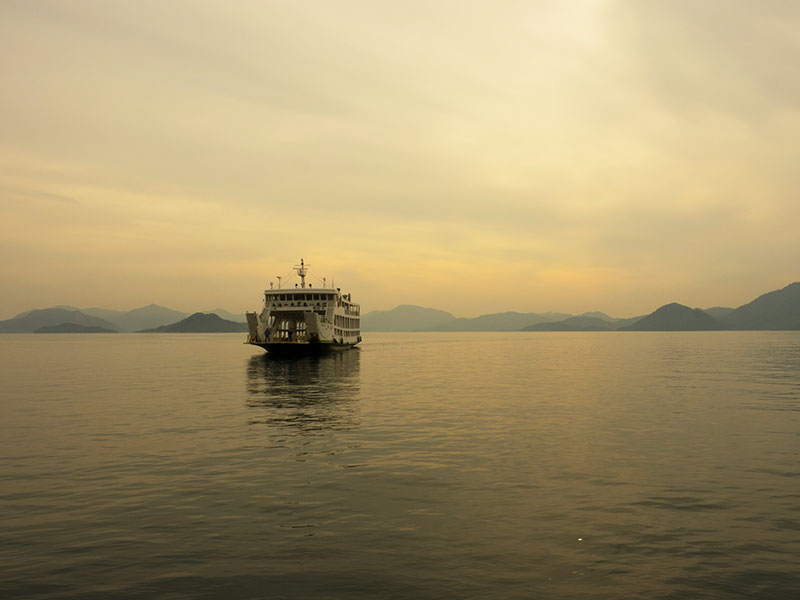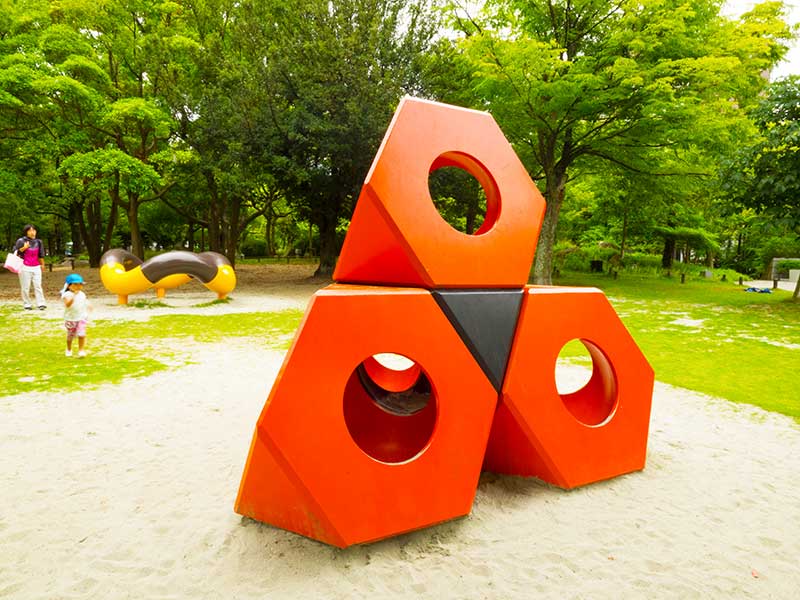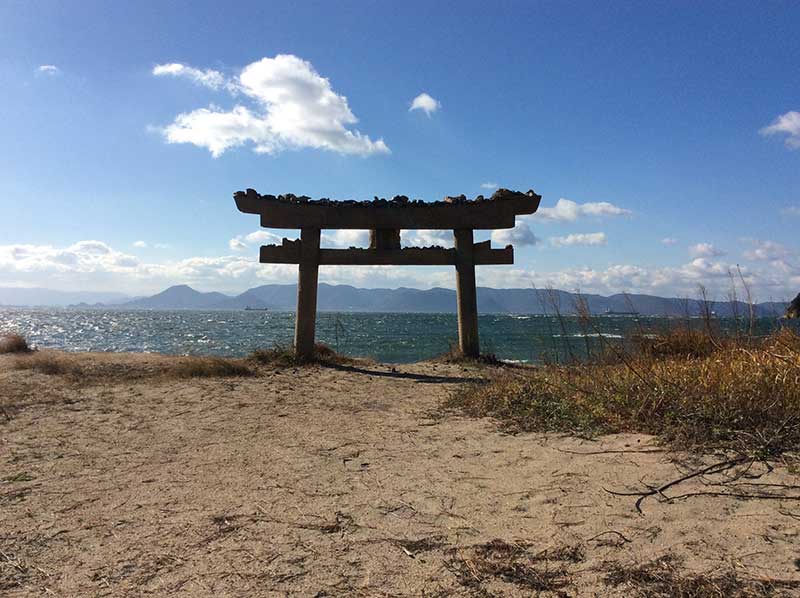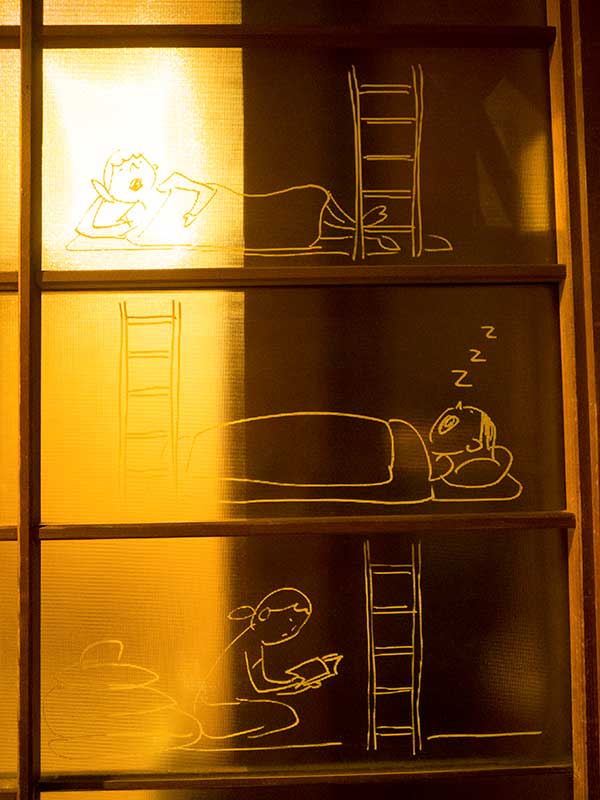An easy walking tour exploring Japan’s Seto Inland Sea, a vibrant region of art, architecture and gourmet dining.
Walk Japan’s gentlest walking tour, suitable for the most leisurely walker, through one of the most intriguing regions of water in the world. An exploration of the Seto Inland Sea’s history from the times of the Silk Road: samurai warlords and pirates, nineteenth-century Western explorers, Japanese and western movies, modern art and architecture, and community revival; comfortable urban hotels complemented with varied cuisine of the region.
Year-round.
A 7-day, 6-night tour starting in Takamatsu and finishing in Fukuyama. Accommodation is mostly in hotels. Please read more on accommodation here. The maximum group size for this tour is 12 persons. We have no minimum size. If we accept a booking we guarantee to run the tour.
The Inland Sea: Art Islands is a Level 2, easy walking fully-guided tour that takes us through Japan’s Seto Inland Sea, a serene body of water that was at the furthest eastern extent of the Silk Road and at the heart of Japan’s earliest history. The Inland Sea is a 450km (280 miles) long body of water surrounded by Honshu, Shikoku and Kyushu, three of Japan’s four main islands. Dotted with an archipelago of islands, islets and shoals, and blessed with calm seas and a clement climate, the region was called the Aegean of the East by nineteenth-century explorers. Thomas Cook, the father of modern tourism, wrote that ‘[It] surpassed all my dreams of beauty of that island- and mountain-studded lake...’ Like Cook, visitors today are still charmed by the Inland Sea’s beauty.
Glistening golden sunrises and slowly subsiding, blood-orange sunsets bookend many sunny days of primary-coloured, far-reaching vistas; while days of mist create shallower perspectives of beautiful, subtly changing gradations of light and shadow. It is a sea of vast and quiet stillness that is broken only by the cry of a sea bird or the rhythmic thudding and lapping wake of the occasional passing boat. On its shimmering steely-blue waters, fishing boats cluster in gently bobbing shoals, ferries ply to and fro with purposeful regularity, and laden coastal freighters slowly make passage to distant ports. Villages of closely clustered clapboard houses, which seem to have been largely bypassed by modern Japan, lie on the shores of larger islands. Here and there simple, elegant Shinto shrines stand on promontories overlooking the sea protecting fishermen and sailors. The hushed solitude of the Inland Sea and its islands are in great contrast to the elegant and fascinating cities, including Takamatsu, Hiroshima and Onomichi, that cluster on the sea’s coastal periphery.
The Inland Sea: Art Islands loosely follows the travels of Donald Richie, one of the greatest observers of modern Japan, who in 1971 wrote his classic book The Inland Sea, a literary travelogue relating his meandering journey east to west through the sea from Himeji to Miyajima. Like Richie we travel from island to island, exploring the landscape, meeting the locals, and musing on Japanese history, society and culture. Unlike him, however, whose journey was a wistful lament on a disappearing way of life, ours is a journey of hope that takes us through the fascinating rejuvenation of communities within the Inland Sea.
The Inland Sea, through which religion, culture and artefacts arrived via China and Korea from across Asia and India, was key to Japan’s early history. Here, in the 12th Century, the legendary Taira and Minamoto Clans fought many of their battles for supremacy, and the infamous suigun pirates, who terrorised the coastal communities of Korea and China, later secreted themselves. In the Edo Period (1603–1868), the sea flourished as part of the highly organised Kitamae-bune shipping route that circuited west Japan as far north as Hokkaido. Daimyo regional barons, Korean delegations and the Dutch traders in Nagasaki also made their way via the Inland Sea to Edo, the feudal citadel that became Tokyo, to pay their allegiance and respects to the all-powerful shogun.
We explore the Inland Sea’s history, culture and society with a focus on the recent past including architecture, art and the gathering pace of recovery in the fortunes of the Inland Sea and its communities. We also explore movies made here and the cuisine of the region, which has at its heart delicious seafood and citrus fruits. On our journey we delve into the work of Japan’s famed movie director Yasujiro Ozu; Kenzo Tange, the father of Japanese modern architecture; and American-Japanese sculptor Isamu Noguchi. All were drawn to the region for their work in the last half of the twentieth century. Since then many of Japan’s best artists and architects, including Kusama Yayoi, Yukinori Yanagi, Toyo Ito, Tadao Ando and SANAA, have been increasingly active in and around the Inland Sea, adding a new vitality that is permeating into the farthest flung islands and injecting a new life and spirit into its communities.
Our journey takes us slowly west on a journey that crosses back and forth over the Inland Sea. We meet in the elegant city of Takamatsu, before hopping from island to island by regular ferries and sea taxis, visiting many sites of art and architectural interest that have given impetus to the region’s revival, including Naoshima, Inujima, Teshima and Momoshima.
Although the tour includes exploration of some of Japan’s more remote islands, each night we stay mostly in comfortable hotels, one with onsen hot spring baths. Walking will include some short inclines, usually over steps that can be completed at an easy pace. Please note that, although the Inland Sea is generally benign the ferries we use to visit some islands are sometimes cancelled due to inclement weather. Walk Japan provides tour participants with easily followed, detailed instructions on how to join the tour.

Please note that The Inland Sea: Art Islands tour includes several transfers by ferry. These are subject to weather conditions and may result in cancelled or delayed sailings resulting in changes to the itinerary.
Day 1 Takamatsu
The tour starts at 6pm in the tour hotel lobby where your tour leader awaits to greet everybody and provide the tour briefing. A short stroll through central Takamatsu leads us to dinner at a hospitable local restaurant.
Accommodation: Western-style Hotel.
Meals: Dinner provided.
Day 2 Takamatsu, Teshima and Inujima Art Islands
After breakfast we board a ferry to begin a day of island hopping. The 450km (280 miles) long Inland Sea is protected by land on all sides and is one of the calmest bodies of saltwater in the world. Even the greatest landlubber should have few problems aboard our water-borne transport for today and the rest of the tour.
Many islands in the region have found a new stimulus through association with the Setouchi Triennale, a contemporary art festival. In common with much of rural Japan, the islands here have long suffered from declining and ageing populations. The principal aim of the festival, which was established in 2010, is to reverse these trends in a sustainable and creative way. Much of the artwork remains in situ after each Triennale and is to be found juxtaposed with everyday life here in the sandy coves, little harbours, and fishing villages that pepper these islands.
On Teshima island we visit the spectacular art museum designed in collaboration by Ryue Nishizawa and artist Rie Naito. The museum structure, an artwork in itself, is a freestanding concrete shell designed to resemble a water droplet poised by water tension. Nishizawa is the co-founder of SANAA architectural practice, another Pritzker Prize winner. From Teshima we cross the waters to Inujima and the audacious Seirensho, a long-disused copper smelting works transformed into an immense artwork to a concept created by Yukinori Yanagi, one of Japan’s most stimulating and interesting artists. Over the coming days, we come across Yanagi’s work elsewhere – and, with luck, the artist himself.
We return to our hotel in Takamatsu, where we relax before enjoying dinner together.
Accommodation: Western-style Hotel.
Meals: Breakfast, lunch & dinner provided.
Day 3 Takamatsu
Takamatsu is an elegant city and one of the driest and sunniest places in Japan. Its port is a busy hub for ferries plying to and from the islands that pepper the Seto Inland Sea as far as the eye can see.
We spend the day exploring Takamatsu by private-hire vehicle, starting at the fabulous Isamu Noguchi Garden Museum, sited in the Mure stone-working district on the outskirts of the city. Isamu Noguchi (1904-1988), who was born to Japanese and American parents, found fame in the 20th Century as a product designer and sculptor. The iconic lights and tables he designed are popular to this day, and his monumental works of art are found around the world. From 1969, Mure was Noguchi’s Japanese home and studio (he also had a base in New York), which has been preserved as a wonderful memorial to Noguchi. Here he was assisted by a local stone mason, Masatoshi Izumi (1938-2021). A self-effacing gentleman, Izumi became an essential collaborator of Noguchi’s and also renowned in his own right for his use of stone in architecture, sculpture and garden landscaping. His workshop is adjacent to the museum and, with luck, we may meet his grand-daughter on our visit.
We spend the rest of the day visiting sites of architectural interest including those designed by Kenzo Tange, one of the most significant Japanese architects of the 20th Century and the nation’s first Pritzker Prize winner. Before lunch we will drop by the George Nakashima Memorial Gallery. We also learn about Masanori Kaneko, Kagawa Prefecture’s first democratically elected governor who had the insight to introduce modern architecture to Takamatsu and was instrumental in bringing Noguchi and Izumi together. In doing so, Kaneko set the early foundations for the growth of modern art in the Inland Sea region.
After lunch of a delicious local delicacy, Sanuki udon wheat noodles, we stop off at the beautiful Ritsurin Koen, a showcase garden of the Edo-Period (1603-1868). It is particularly known for its exquisite niwaki sculpted pine trees, while a tea house aside a pond is the epitome of serene traditional Japanese architecture.
Dinner is not included tonight but your tour leader will be on hand to advise on which restaurant you would like to dine at.
Accommodation: Western-style Hotel.
Meals: Breakfast & lunch provided.
Day 4 Takamatsu – Naoshima – Fukuyama
After an early breakfast in our hotel, we journey to Naoshima by public ferry. Naoshima is at the centre of the Inland Sea’s art boom. Our arrival at Miyanoura, Naoshima’s ferry port, sets the scene for the rest of our day here. The terminal building is a simple modernist structure designed by SANAA. Adjacent is a psychedelic red pumpkin, a motif of Yayoi Kusama, perhaps Japan’s most successful artist today.
A dedicated private-hire vehicle allows us to leisurely explore the whole island including the Benesse House Museum and Art House Project. Tadao Ando, one of Japan’s most prolific architects and another Pritzker Prize winner, was instrumental in the successful revival of Naoshima, which has overcome in a remarkable way the devastation once caused by industry. Besides Ando’s architecture, the Benesse art collection has work by some of the world’s great artists from the West, Asia and Japan. These exhibitions change seasonally and can include work by such artists as David Hockney, Richard Long, Christo and Jeanne-Claude, Jean Michel Basquiat, Bruce Nauman, Lee Ufan, Hiroshi Sugimoto and Yukinori Yanagi amongst many others of the late 20th and early 21st Centuries.
Although a small island, Naoshima has plenty to intrigue us for the whole day. Late in the afternoon, we travel to Fukuyama where we relax over an evening meal in town then retire to our accommodation, a hotel in the centre of the city.
Accommodation: Western-style Hotel.
Meals: Breakfast & dinner provided.
Day 5 Fukuyama – Momoshima – Onomichi
We take trains and the public ferry to Momoshima island to visit Art Base, the home of Yukinori Yanagi, the artist behind Seirensho on Inujima, which we visited on Day 2, and some of the marvellous artworks we saw on display in the Benesse Museum on Naoshima. Art Base is one of Yanagi’s latest projects using art as a catalyst for the revival of the islands of the region. If he is in residence, he will personally welcome us and explain his art and aims.
After lunch we transfer to Onomichi from Momoshima, where we spend the afternoon strolling around this intriguing town set aside a busy waterway. The old centre of tightly packed houses, many built about a century ago in an intriguing Japanese-Western fusion style, in a maze of narrow lanes is perched on a hillside overlooking a charming shopping district and the port area. Here we also find the ancient and beautiful temples that attest to Onomichi’s centuries-old merchant and seafaring wealth, which had its roots in the Kitamae-bune trading ships that plied between Osaka and Hokkaido via the Inland Sea and the Sea of Japan during the Edo Period (1603–1868).
Note: Meeting Yukinori Yanagi is subject to his availability.
Accommodation: Western-style Hotel.
Meals: Breakfast, lunch & dinner provided.
Day 6 Onomichi – Tomonoura
We start our day with a further exploration of Onomichi. The town is regularly used in movies, most famously by Yasujiro Ozu, who filmed his acclaimed Story at Jodo-ji, one of the temples. Nagisa Oshima, who was acclaimed for his later films In the Realm of the Senses and Merry Christmas, Mr. Lawrence, also set one of his earliest films, Boy, in the town.
Our stroll begins at Jodo-ji and takes us on a fascinating, meandering exploration of Onomichi. Although our route today includes a number of climbs and descents, our pace is relaxed, allowing us to gently appreciate the town’s delightful atmosphere and enjoy some splendid vistas that open up to us at higher points. En route we see wonderful old properties that are in different stages of being brought back into use, and meet some of the younger Japanese who are lending a hand in the building work and establishing the new businesses that occupy these splendid buildings. One of these newly revived buildings is Miharashi-tei. Once a sumptuous retreat for a local shipping magnate, the building fell into disuse and decay before being rescued by a local non-profit organisation led by prominent architect Yoshitaka Watanabe. Today, Miharashi-tei has been brought back to life as a lodging and café, and is one of many shining examples of the renewed vigour being brought to Onomichi.
After lunch a taxi transfer brings us quickly to Tomonoura, where we explore this picturesque fishing port of charming clapboard houses and narrow lanes.
In the 1990s, the locals successfully fought to preserve Tomonoura’s bay from development. A nationwide cause célèbre at the time, their efforts protected a delightful sea vista. We undertake a leisurely exploration of the town, which was the inspiration for scenes in Hayao Miyazaki’s Ponyo. It has also been the location for many films including, perhaps surprisingly, Hugh Jackman’s Wolverine.
Our accommodation tonight overlooks the Inland Sea and features onsen thermal hot spring baths. Here we enjoy our final evening meal together at a popular local restaurant.
Accommodation: Onsen hot spring resort.
Meals: Breakfast, lunch & dinner provided.
Day 7 Tomonoura – Fukuyama
We transfer to Fukuyama railway station in the late morning where the tour concludes. From there, onward connections towards Hiroshima, or back towards Kyoto, Osaka and Tokyo are available.
Accommodation: N/A.
Meals: Breakfast provided.
This itinerary is subject to change.
The airport closest to the tour start is Kansai International Airport. The journey is also easily made from Fukuoka Airport, Nagoya’s Central Japan Airport, and Tokyo’s Narita and Haneda International Airports.
-----
FROM OSAKA’S KANSAI INTERNATIONAL AIRPORT (KIX)
JR Haruka Express trains depart for Shin-Osaka Station. Transfer here to the shinkansen bullet train for Okayama. From here the Rapid Marine Liner Takamatsu departs regularly. The total journey is approximately 3 hours.
-----
FROM FUKUOKA AIRPORT (FUK)
A taxi from Fukuoka Airport’s International Terminal is the simplest and, at 10 minutes, the fastest way to travel to Hakata Station, Fukuoka’s main station. Transfer here to the shinkansen bullet train for Okayama for transfer to the Rapid Marine Liner Takamatsu bound for Takamatsu, which is approximately a 3 hour journey.
-----
FROM NAGOYA’S CHUBU CENTRAIR INTERNATIONAL AIRPORT (NGO)
Meitetsu trains depart for Meitetsu Nagoya Station. Change to the neighbouring JR Nagoya Station for onward journey by shinkansen bullet train to Okayama for transfer to the Rapid Marine Liner Takamatsu bound for Takamatsu. The total journey is approximately 3 hours and 30 minutes.
-----
FROM TOKYO’S HANEDA AIRPORT (HND)
Tokyo Monorail trains depart for and terminate at Hamamatsu Station. Transfer here to the trains on either the JR Yamanote or JR Keihin-Tohoku Lines for Tokyo Station. To Takamatsu from Tokyo Station please see the section below.
-----
FROM TOKYO’S NARITA AIRPORT (NRT)
JR Narita Express (NEX) trains depart every 30 minutes for Tokyo Station. To Takamatsu from Tokyo Station please see the section below.
-----
FROM TOKYO STATION
The journey to Okayama is made on the JR Tokaido Shinkansen, one of the super-fast bullet train lines. Departures are frequent and the journey is approximately 3 hours 10 minutes. From here transfer to the Rapid Marine Liner Takamatsu bound for Takamatsu, which takes just under 1 hour.
The pre-tour pack includes detailed instructions, including a map, for travel to the accommodation at the start of the tour.
































